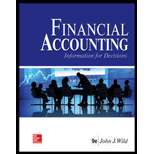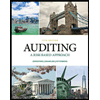
Loose Leaf for Financial Accounting: Information for Decisions
9th Edition
ISBN: 9781260158762
Author: John J Wild
Publisher: McGraw-Hill Education
expand_more
expand_more
format_list_bulleted
Textbook Question
Chapter 6, Problem 1DQ
List the seven braod principles of internal control.
Expert Solution & Answer
Summary Introduction
The principles which are followed for the management in internal control.
Introduction: Internal control is the procedure where the management of the company keeps safeguard the company’s assets, increases efficiency, stops the fraudulent act which takes place among employees.
Answer to Problem 1DQ
Principles of internal control help the management to design, implement and handle employee effectiveness in order to keep defraying with the company. Internal control helps the company implement proper rules and procedures so that they can ensure the financial and accounting information in order to prevent fraud in the company.
Explanation of Solution
The list of principles of internal control:
- Sustain records: By keeping records of the company’s finance and accounts information will help them to be aware of any misleading fraud, or misrepresentation of accounts and documents that can be detected. Likewise, it will become easy for the company to easily monitor and helps the company to protect its assets and carry on with employees.
- Fix responsibility: By giving emphasis on the responsibilities towards employee and assets of the company gives management the strong team to work towards the achievement of the goals of the company. While they clearly identify the terms and responsibility of the employees of the company makes their task easy. After that employee becomes accountable for their work and any fraud they make intentionally or not.
- Record keeping and custody of assets is separated: This principle gives the overview of how the management of the assets is recorded and the custody of assets is maintained by an individual or the department responsible for it.
- Insurance of the company assets and bonding with a key employee. All the assets the company owns, must be insured by the individual or department responsible for it. Against fraud or theft which is likely to occur if left unhandled, as it helps to reduce the company’s risks. The employee who is responsible for the insured assets is least to commit fraud.
- Separate responsibility for the related transaction: This principle gives the responsibility to the different employees for handling the same sort of task but on their own end differently. So like that the separate responsibilities of the same or related transaction are maintained and the person feels the sense of responsibility towards the company.
- Use of technology: By using the technology in order to control the business transactions and the management helps to maintain the flow of control and responsibility in the company. The types of technology that can be used may be a teller machine for counting the cash the company receives. User ID with password controls helps to access the payment system so unauthorized may be prohibited. Access and card and biometric card control will help secure confidential locations like a locker room or server room.
- Regular and independent review: As the company grows all other criteria also expands with it like change in role and technology happens, responsibility tales place, work pressure increases. According to this principle, the regular review of the internal control helps to be less taken by fraud and misleading activities in the company.
Want to see more full solutions like this?
Subscribe now to access step-by-step solutions to millions of textbook problems written by subject matter experts!
Students have asked these similar questions
Suppose that Sandhill Trading Post has the following inventory data:
July 1
Beginning inventory
46 units at $23
$1058
7
Purchases
162 units at $24
3888
22
Purchases
23 units at $26
598
$5544
The company uses a periodic inventory system. A physical count of merchandise inventory on July 31 reveals that there are 58 units on
hand. Using the LIFO inventory method, the amount allocated to cost of goods sold for July is
○ $4198.
○ $4036.
○ $3932.
○ $4106.
Suppose that Sandhill Trading Post has the following inventory data:
July 1
Beginning inventory
46 units at $23
$1058
7
Purchases
162 units at $24
3888
22
Purchases
23 units at $26
598
$5544
The company uses a periodic inventory system. A physical count of merchandise inventory on July 31 reveals that there are 58 units on
hand. Using the LIFO inventory method, the amount allocated to cost of goods sold for July is
○ $4198.
○ $4036.
○ $3932.
○ $4106.
Suppose that Ivanhoe Depot Inc. has the following inventory data:
July 1
Beginning inventory
24 units at $19
$456
7
Purchases
84 units at $20
1680
22
Purchases
12 units at $22
264
$2400
The company uses a periodic inventory system. A physical count of merchandise inventory on July 31 reveals that there are 40 units on
hand. Using the FIFO inventory method, the amount allocated to ending inventory for July is
○ $824.
000
$800.
○ $880.
○ $776.
Chapter 6 Solutions
Loose Leaf for Financial Accounting: Information for Decisions
Ch. 6 - List the seven braod principles of internal...Ch. 6 - Prob. 2DQCh. 6 - Prob. 3DQCh. 6 - Prob. 4DQCh. 6 - Prob. 5DQCh. 6 - Prob. 6DQCh. 6 - Prob. 7DQCh. 6 - Prob. 8DQCh. 6 - Prob. 9DQCh. 6 - Prob. 10DQ
Ch. 6 - Refer to Google’s financial statements in Appendix...Ch. 6 - Prob. 12DQCh. 6 - Prob. 13DQCh. 6 - Prob. 1QSCh. 6 - Prob. 2QSCh. 6 - Prob. 3QSCh. 6 - Prob. 4QSCh. 6 - Prob. 5QSCh. 6 - Prob. 6QSCh. 6 - Prob. 7QSCh. 6 - Prob. 8QSCh. 6 - Prob. 9QSCh. 6 - Prob. 10QSCh. 6 - Prob. 11QSCh. 6 - Prob. 1ECh. 6 - Prob. 2ECh. 6 - Prob. 3ECh. 6 - Prob. 4ECh. 6 - Prob. 5ECh. 6 - Prob. 6ECh. 6 - Prob. 7ECh. 6 - Prob. 8ECh. 6 - Prob. 9ECh. 6 - Prob. 10ECh. 6 - Prob. 11ECh. 6 - Prob. 12ECh. 6 - Prob. 13ECh. 6 - Prob. 14ECh. 6 - Prob. 15ECh. 6 - Prob. 1PSACh. 6 - Prob. 2PSACh. 6 - Prob. 3PSACh. 6 - Prob. 4PSACh. 6 - Prob. 5PSACh. 6 - Prob. 1PSBCh. 6 - Prob. 2PSBCh. 6 - Prob. 3PSBCh. 6 - Prob. 4PSBCh. 6 - Prob. 5PSBCh. 6 - Prob. 6SPCh. 6 - Prob. 1GLPCh. 6 - Prob. 1FSACh. 6 - Prob. 2FSACh. 6 - Prob. 3FSACh. 6 - Prob. 1BTNCh. 6 - Assume you are a business consultant. The owner of...Ch. 6 - Prob. 4BTNCh. 6 - Review the opening feature of this chapter that...Ch. 6 - Prob. 6BTN
Knowledge Booster
Learn more about
Need a deep-dive on the concept behind this application? Look no further. Learn more about this topic, accounting and related others by exploring similar questions and additional content below.Similar questions
- Assume the following informationarrow_forwardThe addition of the cost of goods sold (COGS) and gross profit is the main way that a merchandising company's income statement differs from that of a service organization. Since a merchandising business makes their money by selling material goods, sales revenue, COGS, and gross profit before operating expenditures are subtracted which are all included in its income statement. A service company, on the other hand, does not have a COGS section because they have no inventory involved but instead generates their income through the delivery of services (Weygandt, Kimmel, & Kieso, 2022). The income statement of a merchandising company will usually have only a single-step or could have a multi-step style, with the multi-step clearly separating the net income from the operational income and gross profit. This difference is important because COGS is a major part of financial reporting for merchandising organizations, because it has a direct impact on profitability and financial analysis…arrow_forwardPLease Find correct this account general asolutionsarrow_forward
arrow_back_ios
SEE MORE QUESTIONS
arrow_forward_ios
Recommended textbooks for you
 Cornerstones of Financial AccountingAccountingISBN:9781337690881Author:Jay Rich, Jeff JonesPublisher:Cengage Learning
Cornerstones of Financial AccountingAccountingISBN:9781337690881Author:Jay Rich, Jeff JonesPublisher:Cengage Learning Auditing: A Risk Based-Approach (MindTap Course L...AccountingISBN:9781337619455Author:Karla M Johnstone, Audrey A. Gramling, Larry E. RittenbergPublisher:Cengage Learning
Auditing: A Risk Based-Approach (MindTap Course L...AccountingISBN:9781337619455Author:Karla M Johnstone, Audrey A. Gramling, Larry E. RittenbergPublisher:Cengage Learning

Cornerstones of Financial Accounting
Accounting
ISBN:9781337690881
Author:Jay Rich, Jeff Jones
Publisher:Cengage Learning

Auditing: A Risk Based-Approach (MindTap Course L...
Accounting
ISBN:9781337619455
Author:Karla M Johnstone, Audrey A. Gramling, Larry E. Rittenberg
Publisher:Cengage Learning
Internal Control Components; Author: Accounting Instruction, Help, & How To;https://www.youtube.com/watch?v=D8SSaqpE6L8;License: Standard Youtube License